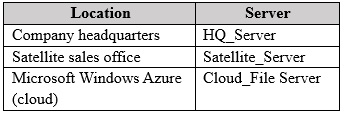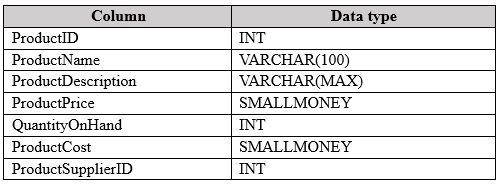

Background -
Corporate Information -
Fabrikam, Inc. is a retailer that sells electronics products on the Internet. The company has a headquarters site and one satellite sales office. You have been hired as the database administrator, and the company wants you to change the architecture of the Fabrikam ecommerce site to optimize performance and reduce downtime while keeping capital expenditures to a minimum. To help with the solution, Fabrikam has decided to use cloud resources as well as on-premise servers.
Physical Locations -
All of the corporate executives, product managers, and support staff are stationed at the headquarters office. Half of the sales force works at this location. There is also a satellite sales office. The other half of the sales force works at the satellite office in order to have sales people closer to clients in that area. Only sales people work at the satellite location.
Problem Statement -
To be successful, Fabrikam needs a website that is fast and has a high degree of system uptime. The current system operates on a single server and the company is not happy with the single point of failure this presents. The current nightly backups have been failing due to insufficient space on the available drives and manual drive cleanup often needing to happen to get past the errors. Additional space will not be made available for backups on the HQ or satellite servers.
During your investigation, you discover that the sales force reports are causing significant contention.
Configuration -
Windows Logins -
The network administrators have set up Windows groups to make it easier to manage security. Users may belong to more than one group depending on their role.
The groups have been set up as shown in the following table:
Server Configuration The IT department has configured two physical servers with Microsoft Windows Server 2012 R2 and SQL Server 2014 Enterprise Edition and one Windows Azure Server. There are two tiers of storage available for use by database files only a fast tier and a slower tier. Currently the data and log files are stored on the fast tier of storage only. If a possible use case exists, management would like to utilize the slower tier storage for data files. The servers are configured as shown in the following table:
Database -
Currently all information is stored in a single database called ProdDB, created with the following script:
The Product table is in the Production schema owned by the ProductionStaff Windows group. It is the main table in the system so access to information in the
Product table should be as fast as possible. The columns in the Product table are defined as shown in the following table:
The SalesOrderDetail table holds the details about each sale. It is in the Sales schema owned by the SalesStaff Windows group. This table is constantly being updated, inserted into, and read. The columns in the SalesOrderDetail table are defined as shown in the following table:
Database Issues -
The current database does not perform well. Additionally, a recent disk problem caused the system to go down, resulting in lost sales revenue. In reviewing the current system, you found that there are no automated maintenance procedures. The database is severely fragmented, and everyone has read and write access.
Requirements -
Database -
The database should be configured to maximize uptime and to ensure that very little data is lost in the event of a server failure. To help with performance, the database needs to be modified so that it can support in-memory data, specifically for the Product table, which the CIO has indicated should be a memoryoptimized table. The auto-update statistics option is set off on this database. Only product managers are allowed to add products or to make changes to the name, description, price, cost, and supplier. The changes are made in an internal database and pushed to the Product table in ProdDB during system maintenance time.
Product managers and others working at the headquarters location also should be able to generate reports that include supplier and cost information.
Customer data access -
Customers access the company's website to order products, so they must be able to read product information such asname, description, and price from the
Product table. When customers place orders, stored procedures calledby the website update product quantityon-hand values. This means the product table is constantly updated at randomtimes.
Customer support data access -
Customer support representatives need to be able to view and not update or change product information. Management does not want the customer support representatives to be able to see the product cost or any supplier information.
Sales force data access -
Sales people at both the headquarters office and the satellite office must generate reports that read from the Product and SalesOrderDetail tables. No updates or inserts are ever made by sales people. These reports are run at random times and there can be no reporting downtime to refresh the data set except during the monthly maintenance window. The reports that run from the satellite office are process intensive queries with large data sets. Regardless of which office runs a sales force report, the SalesOrderDetail table should only return valid, committed order data; any orders not yet committed should be ignored.
Historical Data -
The system should keep historical information about customers who access the site so that sales people can see how frequently customers log in and how long they stay on the site.
The information should be stored in a table called Customer Access. Supporting this requirement should have minimal impact on production website performance.
Backups -
The recovery strategy for Fabrikam needs to include the ability to do point in time restores and minimize the risk of data loss by performing transaction log backups every 15 minutes.
Database Maintenance -
The company has defined a maintenance window every month when the server can be unavailable. Any maintenance functions that require exclusive access should be accomplished during that window.
Project milestones completed -
Revoked all existing read and write access to the database, leaving the schema ownership in place.
Configured an Azure storage container secured with the storage account name MyStorageAccount with the primary access key StorageAccountKey on the cloud file server.
SQL Server 2014 has been configured on the satellite server and is ready for use.
On each database server, the fast storage has been assigned to drive letter F:, and the slow storage has been assigned to drive letter D:.
You need to implement changes to the system to reduce contention and improve performance of the SalesOrderDetail table.
Which three actions should you perform? Each correct answer presents part of the solution. (Choose three.)
msamm
Highly Voted 5 years, 8 months agoTheSwedishGuy
5 years, 4 months agochh2
5 years, 3 months agoCococo
4 years, 8 months agoCococo
Most Recent 4 years, 7 months agoSlava_bcd81
4 years, 9 months agoIva10
4 years, 11 months agojolsca
4 years, 9 months agoKC
4 years, 9 months ago